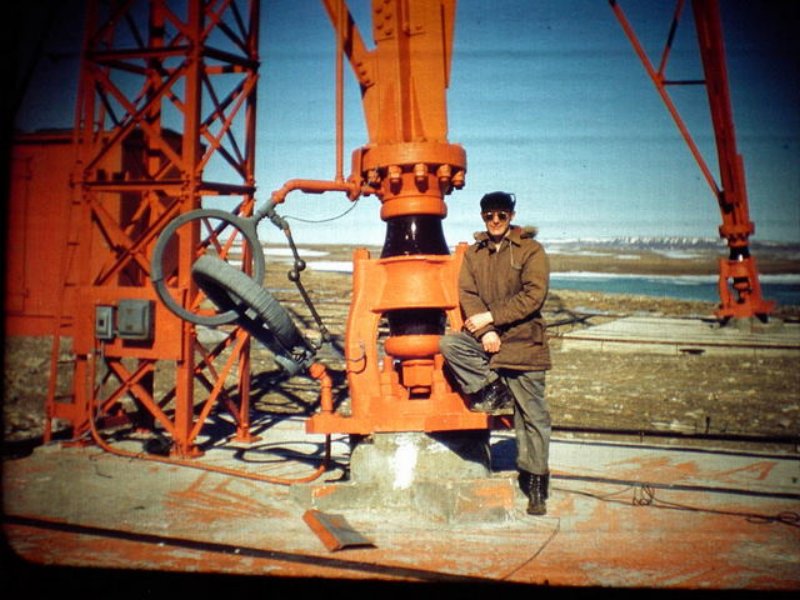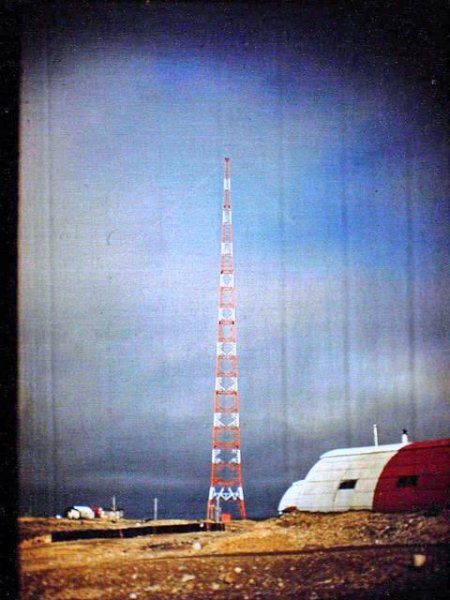
|
1951-1953 Cambridge Bay Radio Souvenirs of Cambridge Bay, Nort West Territories (now Nunavut) from Milton Watts
Cambridge Bay consisted of a HBC trading post, two man RCMP Detachment and a closed Anglican mission until the late 1940’s when construction started on one station of the Beetle Loran chain. Before this station was completed it was abandoned. This left a number of Quonset huts, Jamesway huts, a few wooden, tarpaper covered buildings, and a 633 foot self supported tower with top loading. In 1949 these were turned over to the DOT. The DOT selected two of the wooden buildings for use. One became the power house and garage and the other was converted into living quarters and radio room. They became Cambridge Bay radio metrological station.
The RCAF was to started their Arctic Survival training school there. This would also provide the necessary air transportation. Later one of the local bush airlines objected to the RCAF doing the work that they could do. It was then turned over to them. They were incapable of properly doing the work and this presented problems. I arrived in August 1951.What could have been a seven hour flight by RCAF and was supposed to be a two day trip to Cambridge turned into a 12 day nightmare.
Our usual northern issue had been augmented by a very necessary sleeping bag, rubber boots and a good quality leather jacket. The boots and jacket were invaluable during the summer. The sleeping bag was our only bedding and had to be returned to stores when we left. I cannot imagine the smell when we returned them with 365 or so nights of sleeping and no cleaning.
Radio equipment was two RCA AT3 transmitters located in the radio room. One with two RCAF A./G frequencies and the other for DOT 4885 CW and 5680 A/G. Three AR88 receivers. A RCA 260B 1KW LF transmitter modified for use as an NDB and using the big tower. It was also used for P/P MCW to our main contact station RCCS in Norman Wells. Power supply was two D4600 Diesel electric plants. Mobile equipment was a TD14 crawler tractor, Bullmoose forklift, Sicard Jr. Snowblower and a former Marmon - Harrington Ford snowblower converted to a flat bed truck. It had no door, no windows, no seat (we used a wooded box). No second gear and poor brakes. It also did not have a license or insurance. Who needs those?
Staff was three RO, including the OIC, one mechanic, one cook and two local Eskimos. We did not have a continues watch. Our duties were weather observation every three hours, Three pilot balloons a day. Four is normal, but that would have required a fourth operator on station. Aircraft watch and NDB on request. Contact with Coppermine DOT, HBC Bathurst Inlet and Spence Bay twice a day and RCCS Norman Wells every three hours.
Recreation equipment was almost non existent. Two canoes, but no outboards and no paddles. An RCAF crash launch, but it’s motor was very poor condition. We had a fair size library of old books donated to the US armed forces during WW2. Board games and cards. The RCAF had also left us two rifles and lots of ammunition. Great for shooting rocks and tin cans, but, since we were in a no hunting area, not good for hunting. Three Very pistols and boxes of yellow, red and green flares completed our fun stuff. The DOT did provide a table mount broadcast/SW radio. I had my own ham station VE8MW with a Johnson Viking transmitter and a National receiver. We managed to keep busy and happy. In long evening discussions managed to come up with solutions to all the worlds problems. A half mile walk would take us to the “Constables Club” aka the police post for enjoyable card games. A half mile walk across the bay would allow us to visit the HBC. The house that is, the store was only open on request and was unheated. The better to discourage trappers from hanging around the post, and also reduce cost. In October we were asked to start clearing a runway as soon as the ice was thick enough. By November we had a good clear runway and were eagerly awaiting fresh supplies and most importantly - mail. Somehow something went wrong. The RCAF cancelled their survival school that year, so no regular flights. No Christmas mail until the DOT chartered a flight in mid January. Wonderful to get it but it left with one operator who quit. The bush airline would not fly if the temperature dropped below minus 50F. There are certain advantages at times to being in charge of the temperature.
Later in the winter we provided NDB and communication to the first two SAS flights from Edmonton to Europe. For the second flight they used Cambridge almost exclusively from Edmonton to Greenland. All A/G CW. March brought a strange visitor. A USAF C54 flight planned from Coral Harbour to Cambridge to Norman Wells. It made no sense to us they flew a hundred miles or so then circled around and did it again and again. A couple of years later we realized that they were checking out sites for the DEW line.
Our NDB antennae. That’s a lot of steel sticking up. 633 feet tall with top loading. Note the lighting transformer. That’s a boarding platform behind the transformer, which made it possible to climb a ‘hot‘ tower. As well as radio beacon, it made a good visual aid, particularly in the dark, with its obstruction lighting. On the distant horizon is Mt. Pelly. It’s south wall, nearly vertical and covered in snow during the winter, made a great day time beacon. Bush pilot’s liked it. The low winter sun reflected off it.
Pibals were a daily routine, requiring two of us. One outside observing and one inside plotting. Balloons were filled with helium. During darkness a paper ‘Japanese lantern’ with a candle in it was hung on the balloon. Occasionally the paper lantern would start to burn resulting in a quick release or burnt mitten. Generally that meant doing it again. On windy days it was not great for the outside person, but the flight would be over very quickly.
The cook was probably the most important person there. Initially, on my arrival, a new cook was there. A young fellow who couldn’t even boil water. One notable meal consisted of burnt steak. Nothing else, not even tea or coffee. Fortunately Leo Zuccato, who had been supervising the move into our new station, was still there. A message was sent off to the office to get a new cook or expect a wholesale departure of everyone. This resulted in the arrival of an older, very drunk cook. He stayed for about 6 months. Departed in the same condition, but never had a drink all the time he was there. We ate like royalty with Jim cooking. He was up at 6 AM preparing breakfast and went to bed at 8PM, and DO NOT disturb him. During the day we could have coffee and raid his goodies drawer, but don’t dare touch what he was preparing. In the evening or at night you could do the same, but clean up the dishes. That rule did not apply to the midnight shift operator. Jim reasoned that since he had probably missed lunch he was entitled to his regular lunch during the night.
Our two local employees, Peter and James were good employees. James first job of the day was to empty the “honey bucket”. Late in the summer the HBC ship Ft .Hearne arrived. Busily hauling boxes of food supplies into our kitchen store room, James remarked “Today I haul it all in, tomorrow I start hauling it all out.” The arrival of the Ft. Hearne was always a big event. In addition to the Ft. Hearne two other smaller HBC vessels Nigalik and Nechelik arrived. They were used for transportation to smaller posts.
The Air Force had a large ice melting plant for water. This involved several large bathtub shaped tanks. One of these was installed in the attic of our quarters providing running water. It was filled through a hatch in the roof with water hauled from a nearby lake. Another tank was mounted on a platform outside and was used to provide fuel oil for our furnaces and stove. Fuel oil was hand pumped from 45 gal drums into this tank. Two furnaces were used. Although the building had only a minimal amount of insulation the heating was normally adequate. On occasion when a blizzard was blowing, snow would drift in under the doors.
Our contact for all weather and most other traffic, except for aircraft movement, was with RCCS station in Norman Wells. Their radio procedure was different then ours. They did not have weather symbols on their typewriter or teletype and did not use them on CW. At Cambridge we used their system for Norman Wells and DOT system for DOT stations.
Prior to the arrival of the DOT the HBC post used their own radio equipment to maintain contact with Coppermine Radio. For the most part this was commercial traffic for HBC. With the DOT now operating they no longer made any use of their station. The very few commercial messages were handled by DOT Cambridge. No procedure had been set up to do this. As a result we would receive the commercial message by hand from HBC or others and transmit it to Coppermine Radio who would relay it to Churchill. Coppermine would do the bookkeeping, as they always did with HBC system. If it was not HBC traffic, the originator would pay HBC. The silly part was that we were much better equipped and situated then Coppermine to work Churchill. We would originate it. Coppermine would do the bookwork. HBC would get paid. What a system! I suppose in the long term, DOT would collect the normal fees from HBC.
Cambridge Bay was the where Roald Amundsen’s historic vessel the Maud was abandoned. The HBC had purchased it and renamed it Bay Maud. They found it was built to freeze into the ice for long periods. It was too slow and too heavily reinforced to carry much cargo.
Spring was wonderful time there. With 24 hour daylight, it gave lots of opportunity for hikes while on midnight shift, between the 2AM AND 5AM weather report. August 1953 came along and with it my departure from Cambridge Bay. A clear but blustery day with the bush line Norseman tied up to our dock and ready to go. The pilot was worried about the aircraft being blown into the dock as soon as he tried to taxi away. To avoid this he asked the Eskimos standing there to hold on to the tail while we taxied out. He reasoned they would let go before being pulled into the water. Instead they decided to give us a hand by pushing the tail out and letting go. The wind caught it and slammed the tail back into the dock. We taxied out into the bay, the pilot climbed out on the float, had a look at the tail and saw no reason to stay. I was on my way to Medicine Hat.
|
|
Links - Liens
|












